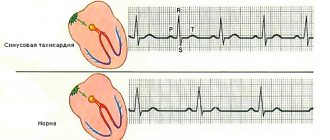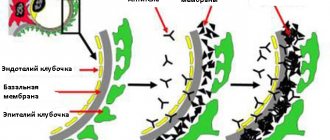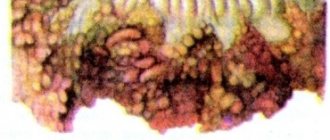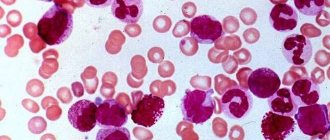Location
Tumors of the choroid plexus can be localized in internal organs, in the brain, and on the skin. In another way they are called angiomas, there are a lot of varieties. What type they are classified as depends on the vessels that are affected, general symptoms, and the characteristics of the development of the phenomenon. It is noteworthy that tumors of vascular origin pose varying degrees of danger to the body. They can be harmless or pose a serious danger to life.
Medicine has not yet found an answer to the question of why they develop. The mechanism of their appearance is considered a poorly studied area. But it is known for certain that sometimes benign vascular tumors are congenital. When parents see this, they usually start to panic. And this is really a reason to turn to specialists.
Diagnostic methods
If the tumor is superficial, inspection and palpation are sufficient. After pressing, the hemangiomas turn pale and shrink. To diagnose subcutaneous formations and suspected angiosarcoma, a biopsy is mandatory.
To detect vascular tumors of internal organs, use:
- X-ray of the bones of the limbs, spinal column, pelvic region, skull.
- Angiography or lymphangiography of the anatomical zone where the tumor may be localized.
- Ultrasound to identify the location, depth of penetration, degree of compression of neighboring organs. Using this method, blood flow in the tumor can be assessed.
- CT and MRI are performed to detail the structure and size of the formation.
If there is a suspicion of a tumor of the lymphatic vessels, then during a diagnostic puncture it can be confirmed by transparent contents with a yellow tint. This allows it to be distinguished from a cyst, hernia, lipoma or lymphadenitis.
Varieties
The vascular tumors presented in our article in the photo differ from each other. For the most part, there are two large groups - hemangiomas and lymphangiomas. In addition, they can be both benign and malignant.
However, the word “cancer” is not used in this case, since it denotes a pathology of the epithelium, and in the case of tumors of vascular tissue, we are more likely talking about sarcoma.
Cavernous hemangioma
This variety is considered the rarest. This type of vascular tumor consists of thin-walled vessels with wide lumens. Blood clots are observed in the cavities. Cavernous hemangioma usually affects the gastrointestinal tract. Often this is a vascular tumor of the skin.
It looks like a spongy tumor filled with blood. It is lumpy and red-bluish. However, there are many types of hemangiomas, depending on additional features - features of their structure, character.
The cavernous variety has purple hues. Typically, such a tumor is a spot that rises above the skin. At the same time, most of the affected area is located inside, under the skin. This is a spongy formation that sometimes affects muscle tissue. This phenomenon is dangerous due to the fact that there is an increased vulnerability to injury. Sometimes bleeding occurs, and this increases the likelihood of infection. If the angioma is large, blood circulation in the affected area may be impaired. Then abnormalities will appear in healthy tissue nearby.
Treatment options for hemangiomas
A single small hemangioma usually does not require treatment, as it goes away on its own. Treatment of vascular tumors that cause lesions or ulcers is required. There are several treatment options:
- Corticosteroid drugs are injected into the hemangioma to reduce its growth and relieve inflammation.
- Beta blocker creams are applied several times daily for 6 to 12 months to small superficial hemangiomas. The drug has no contraindications. Beta-adrenergic blockers in tablet form are also used in childhood.
- Laser therapy is used to remove hemangioma. In difficult cases, the surgeon uses a laser on the vessels to reduce redness and speed up the process of tissue regeneration.
- Becaplermin gel is used to heal ulcers on superficial cutaneous hemangiomas, but does not affect the tumor. The product is not used often due to the increased risk of cell degeneration.
- Surgery is necessary for large lesions in sensitive areas such as the eyes, nose, and throat.
Internal hemangiomas require treatment if they are large enough to impair organ function or cause pain. Surgical removal of a tumor, an organ as a whole or a section thereof, or embolization of an artery that supplies blood to the tumor is used.
Beta blockers in the treatment of childhood hemangiomas constrict blood vessels, suppress their growth, stimulate the death of tumor cells, and at the site of their new formation, creams should be used in the proliferative phase. The drugs act on beta-adrenergic receptors, which are expressed precisely during the period of tumor growth.
In domestic practice, Propranolol is used among beta blockers. Children with vascular manifestations are prescribed doses of 1–3 mg per kilogram of body weight per day. Side effects of a beta blocker include sleep disturbances, decreased blood pressure, and weakness in the child.
Lymphangioma
Lymphangioma is also a tumor of the vessels of the lymphatic system. It can be limited, cavernous, progressive. Children are most susceptible to the first type. The location of such a vascular tumor is usually on the thigh or buttocks.
Cavernous lesions are most often congenital. Progressive lymphangioma usually occurs in males. It looks like a pink neoplasm on the limbs, less often on the torso.
Superficial hemangioma
Usually people suffer from superficial hemangiomas. And even if these are not malignant vascular tumors, they can cause a lot of discomfort to the owner. Those who carefully monitor their appearance suffer especially.
The superficial variety is usually congenital and may also appear in early life. This is a painless point that is located on the face.
Sometimes tumors of the choroid occur. Less often it is noticed on the neck, in the scalp. Such lesions appear three times more often in girls than in boys.
The main responsibility of parents is to pay close attention to the appearance of even small formations. Pathological processes of this kind are very insidious: they can grow instantly, spreading throughout the body. Vascular tumors of the face can lead to skin necrosis, and ulcers with bleeding may appear. Subsequently, inflammatory processes may begin. And even if the tumors are painless, they can harm the appearance. They can be extremely difficult to eliminate once they have become active.
Why is it dangerous?
There are many different complications of vascular tumors, which depend on the location, size and growth rate, as well as the type of hemangioma.
The greatest danger is:
- Ulceration. The most common complication of hemangiomas, characterized by rapid, rapid growth. The appearance of ulcers above the surface of the hemangioma is often combined with bleeding from the neoplasm.
- Bleeding. It can be small or abundant, pulsating, depending on which vessels are involved in the formation of the tumor. Usually a cause of great concern for the parents of a patient with a hemangioma, however, such bleeding can easily be stopped by simply pressing a finger wrapped in sterile gauze or bandage.
- Suppuration. The addition of a secondary bacterial infection with the development of an inflammatory process often occurs in small patients with ulcerated hemangioma, especially with improper skin care during this period.
- Impaired function of the sensory organs. With hemangiomas located near the eyes and ears, visual and hearing acuity may decrease. Neoplasms in the nasal area can lead to its deformation and impaired sense of smell.
- Difficulty breathing. Large, rapidly growing hemangiomas in the neck area can cause compression of the respiratory system and disruption of the breathing process.
- Violations of the function of internal organs. Vascular neoplasms that arise in the liver, kidneys or other organs lead to disruption of their normal functioning and metabolic pathologies.
Hemangiomas of large internal arteries and veins are extremely rare. With a rapid increase in size, such tumors can block the lumen of blood vessels and lead to circulatory problems in the baby.
Treatment tactics
It is noteworthy that, according to some doctors, hemangioma sometimes does not need to be treated. She disappears on her own. And doctors confirm that, as a rule, vascular tumors resolve after reaching 5-7 years of age, leaving no trace. However, the decision to use wait-and-see tactics should be made directly by the specialist. It is necessary to take into account the clinical picture and the development of pathology.
There is no doubt that formations that interfere with eating, breathing, and hearing should be treated as soon as possible. Be sure to remove tumors on the eyelids, otherwise they can damage the visual organs. Vascular brain tumors, as well as hemangiomas located in places where constant friction occurs, pose a danger. We are talking about the genital area, neck, back of the head, and back.
Sometimes parents are very afraid of surgical interventions in the early years of a child’s life. But you should not be afraid of removing vascular tumors - after all, modern medicine reduces the risks of complications to a minimum, operations of this kind are painless and safe for children. In addition, earlier removal reduces the likelihood that in the future they will be bothered by cosmetic defects associated with the hemangioma.
Treatment in a child
In the treatment of hemangioma in newborns, the same techniques are used as in adults. Point and small vascular neoplasms on the skin can be removed using electrocoagulation, cryodestruction or laser exposure.
Small cavernous and mixed hemangiomas respond better to sclerotherapy.
For large tumors or their deep location, preference is given to surgical excision or embolization, that is, blocking the lumen of the vessel feeding the tumor.
The choice of treatment tactics depends on the size and location of the hemangioma, the rate of its growth, the ability for spontaneous regression, the presence of complications, as well as the general condition of the baby.
Removal in an infant under one year old
Hemangiomas in infants can disappear either independently or during conservative treatment with propranolol or corticosteroids. In order not to expose the baby’s delicate body to the influence of various medical procedures, doctors advise adhering to a wait-and-see approach and deciding whether to remove the tumor after the first year of life.
The exceptions are hemangiomas that disrupt the functions of various organs and systems, tumors complicated by severe bleeding and suppuration, and deforming neoplasms in the facial area.
Hemangiomas located:
- On the face (in the eye area, in the ear area).
- On the mucous membrane of the mouth.
- In the neck area.
- In the anogenital zone.
Hemangiomas that rapidly increase in size are also subject to surgical or other types of treatment.
If the tumor has doubled in size within one week and does not respond to conservative treatment, it should be immediately disposed of radically.
Cherry angiomas
People over 30 years of age often develop multiple cherry-colored angiomas. Their diameter is about 1-5 mm. At first they are red-cherry, and then reach a burgundy color. There are often a lot of them - there can be several tens or hundreds of them. As a rule, these are not malignant tumors, but if their number increases sharply, this phenomenon is a direct indication for contacting an oncologist.
Venous hemangioma
Venous vascular tumor is a bluish-colored protrusion on the skin. As a rule, it appears in a place characteristic of varicose veins. For example, it can easily occur on the limbs of an adult. Such a tumor indicates the beginning of a whole complex of pathologies in the veins. Venous blood stagnates here. Blood clots are usually localized here. Angioma of this nature does not tend to affect the main vessels; it is located in the muscles or deep in the tissues. The danger is that the affected area can expand greatly in a very short time. Then a whole network of communicating foci of branched angioma is formed.
Benign vascular tumors
Benign tumors arising from blood vessels are called hemangiomas, and from lymph nodes - lymphangiomas. 45% of all soft tissue tumors and 25% of all benign tumors are hemangiomas. According to the microscopic composition, these diseases are divided into benign hemangioendotheliomas, juvenile (capillary), racemic, cavernous (cavernous) hemangiomas and hemangiomatoses.
Benign hemangioendothelioma is a fairly rare disease that mainly manifests itself in childhood. The areas of localization of this tumor are the skin and subcutaneous tissue. Capillary hemangioma is also most common in children. It is localized mainly in the skin, less often in the liver, mucous membranes of the gastrointestinal tract and oral cavity. Often has infiltrating growth.
Racemic hemangioma can be arterial, venous, or arteriovenous. It has the form of a conglomerate of viciously developed vessels. Localized in the neck and head area. Cavernous hemangioma consists of vascular cavities of different shapes and sizes that communicate with each other. Most often it is localized in the liver, less often in the gastrointestinal tract, muscles and spongy bones.
Geomangiomatosis is a fairly common dysplastic disease of the vascular system, which is characterized by involvement of the entire limb or its peripheral part in the process. The cause of the development of hemangiomas, as a rule, is an excessive number of vascular primordia, which begin to profile in the embryonic period or due to damage. It is believed that benign vascular tumors represent a middle link between developmental anomalies and blastomas.
Hemangiomas are classified based on location. They can develop in the integumentary tissues (mucosa, skin, subcutaneous tissue), elements of the musculoskeletal system (muscles, bones), parenchymal organs (liver). Most often, hemangioma is localized on the face in the form of a pink or purple-blue painless spot, slightly raised above the skin. If you press on this place with your finger, the hemangioma thickens and turns pale, and then fills with blood again.
A characteristic feature of this disease is rapidly progressive growth: usually in a newborn child, a hemangioma has the appearance of a small dot, which after a few months can grow into a large spot, leading not only to a cosmetic defect, but also to functional disorders. Complications of hemangioma include ulceration, infection, bleeding, phlebitis and thrombosis. A tumor of this type, located on the tongue, can reach large sizes and therefore make breathing and swallowing difficult.
Hemangiomas of muscles and subcutaneous tissue most often appear on the lower, less often - upper extremities. However, changes in the skin above the tumor are not always observed. A hemangioma communicating with a large arterial trunk is detected by pulsation and listening to noise above the site of its localization. Concomitant phlebitis and thrombosis often cause pain in surrounding tissues. Prolonged tumor growth and lack of treatment can lead to muscle atrophy and impaired limb function.
Cavernous bone hemangiomas account for no more than 1% of all benign tumor diseases of bone tissue. They occur at any age in men and women. Most often they are localized on the spine, bones of the skull and pelvis, less often on the long tubular bones of the arms and legs. Often the lesions are multiple and last for a long time without manifestations. Subsequently, pain, bone deformations and pathological fractures appear. When the vertebrae are damaged, radicular pain occurs due to compression.
Glomus tumor (glomangioma, Barre-Masson tumor) is also benign. It is rare and mainly affects older people. The most common sites for this tumor are the nail beds of the fingers and toes. Glomangioma has a purplish-bluish color, a round shape, a diameter of 0.5-2 cm. The glomus tumor reacts to minimal external irritation with a strong pain symptom.
It is quite easy to diagnose hemangiomas of muscles and skin, since they have characteristic features: pronounced color and the ability to contract when squeezed. Bone hemangiomas are diagnosed using X-ray examination. An image of the affected spine may show swollen vertebrae, rough, vertically directed trabeculae in the bone structure with individual rounded enlightenments. Similar changes are also detected in the arches and transverse processes.
Pathological fractures of the vertebrae make it very difficult to diagnose bone hemangioma, since in this case the structure of the spine changes due to wedge-shaped deformation. It is especially difficult to make a correct diagnosis if there are also no changes in the arches and transverse processes. Hemangiomas of long tubular bones appear as a club-shaped deformation of the bone and a honeycomb pattern of the edges. The angiography method allows identifying cavities and lacunae in the affected area of the bone.
The prognosis for the treatment of benign neoplasms of blood vessels is positive. The following methods are used to treat hemangiomas:
- injections of sclerosing agents, in particular 70% ethyl alcohol;
- radiation therapy - for capillary and cavernous hemangiomas of the integumentary tissues and the musculoskeletal system in the presence of pain, dysfunction and other clinical manifestations;
- cryotherapy – for small hemangiomas of the skin;
- surgical intervention (excision) is the main and most radical method of treatment, ensuring complete recovery.
The easiest way to get rid of hemangioma is in early childhood, when the tumor has not yet reached a large size. The most difficult to treat surgically are overgrown hemangiomas located in areas of large vessels and on internal organs.
Treatment of superficial brain tumors
It is noteworthy that sometimes a vascular tumor is located in the brain. In such a case, the person usually suffers from many additional symptoms. So, problems with maintaining balance may begin. A vascular tumor of the brain provokes pain, dizziness, and double vision. The patient usually gets tired quickly. For these reasons, treatment in this case must begin immediately, and at the first symptom, consult a doctor for a thorough diagnosis.
Diagnosing superficial vascular lesions is not difficult - the signs of these phenomena have been studied quite well. In any case, additional histological studies are required to establish the exact type of tumor and exclude the possibility that it is malignant. Benign pathologies are not always treated. But there are indications for mandatory therapy.
So, it is imperative to get rid of angiomas, which often bleed and where ulcers appear. If the tumor grows rapidly, immediate medical intervention is also necessary. Sometimes angioma interferes with the comfortable wearing of clothes and shoes. If, when a neoplasm appears, the functional abilities of internal organs decrease, it is important to remove it in a timely manner.
Treatment methods
Modern medicine includes many methods of treating vascular tumors of various natures. For the most part, they are aimed at stopping the further development of angioma and restoring blood flow in the affected area. Tissue that has been irrevocably deformed is also removed.
Laser surgery is considered one of the most promising methods of therapy. The tumor is removed in layers without destroying entire tissues. This is an effective technique.
If the tumor is small, electrocoagulation is often used. This is a procedure that involves cauterizing the affected areas with an electric current. Despite the fact that this method is painful, it is effective.
Cryotherapy involves applying cold to a vascular tumor. Freeze the affected area with nitrogen or carbon dioxide. As a rule, children can easily tolerate the procedure and it is effective.
Other treatment methods are required for tumors that are located in hard-to-reach places or have already managed to grow over a fairly large area. In this case, radiation therapy helps - shock doses of radiation are used. This requires additional treatment.
Sometimes oncologist surgeons resort to sclerotherapy for tumors. During this process, a special composition is introduced into the tissue; as a rule, it is based on alcohol. This procedure is painful, and it is used quite rarely: the duration of the full course is quite long.
Sometimes the most effective method is surgery. This is especially true for vascular tumors that are located deep in the tissues. In some cases, this is generally the only way to get rid of pathology, while other methods simply cannot cope with such a task.
If it is not possible to perform surgical treatment of an extensive angioma, they resort to hormonal therapy. Hormones are able to stop further development of the tumor, the vascular networks of the affected area begin to dry out.
Malignant vascular tumors
Malignant tumors of blood vessels include hemangiopericytomas and hemangioendotheliomas; some experts combine them into one group - angiosarcomas. Fortunately, they are much less common than benign neoplasms. People of both sexes aged 40-50 years are prone to developing angiosarcoma.
Most often, the tumor is located in the thickness of the tissues on the lower extremities. The tumor node has an uneven surface without clear contours. Often, several nodes merge, forming a diffuse infiltrate. Angiosarcomas differ from other types of soft tissue sarcomas by rapid growth, a tendency to grow through the skin, ulceration, and metastasis to regional lymph nodes, bones, lungs and other internal organs.
Diagnosing angiosarcomas in the early stages is quite difficult. The disease is recognized by its rapid course with a short history, the typical location of the tumor and its tendency to ulcerate. The final diagnosis is established after cytological examination of the punctate and morphological analysis of the tumor.
In the early stages, surgical treatment of angiosarcoma is used by excision of the tumor itself, surrounding tissues and retonary lymph nodes. If a large tumor is located on a limb, amputation is usually performed. Radiation therapy is sometimes used in combination with surgery. It can also be used as an independent method for palliative purposes.
But, in spite of everything, angiosarcoma is the most malignant tumor, which in most cases leads to the death of the patient within 2 years after diagnosis, and only 9% of patients survive 5 years.
Folk remedies
Treatments proposed by traditional healers are popular and effective. It is unlikely that you will be able to completely rely on them and get rid of a vascular tumor - no person without special medical equipment can accurately determine the type of tumor. Whether it is malignant or benign can only be confirmed by analysis.
Traditional healers suggest using tinctures of medicinal herbs to get rid of hemangiomas. As a rule, aloe, celandine, and walnut are used. There are also radical methods - pulling small tumors so that blood stops flowing to them. But you need to keep in mind that you should not resort to any method without informing your doctor. So, celandine is generally poisonous, and if a person takes tinctures from it, this can make the main methods of treatment ineffective or harmful. If a doctor is already treating a patient’s vascular tumor through radiation therapy, and the patient secretly takes celandine from the doctor, the body may simply not withstand such a concentration of toxic and harmful effects.
Traditional tinctures are prepared simply - you need to take two tablespoons of the plant and pour in 0.5 vodka. After placing the tincture in a dark place, forget about it for two weeks, having previously tightly covered the product with a lid. After this period, they begin to take it.
Hemangioma inside the brain
It is important to diagnose a brain tumor as soon as possible. After all, if it grows, the consequences may be the most severe. If it would not cause such harm in other internal organs, here its effect may be critical. As a rule, such pathologies arise as a consequence of traumatic brain injury. Sometimes the reasons lie in a hereditary factor.
Often, a vascular tumor of the brain leads to epileptic seizures, thinking disorders, and intellectual abilities can be significantly reduced. The sense of smell and taste is impaired, and speech may become slurred. Sometimes a person suffers from vomiting, tinnitus, and vision may deteriorate.
If an aneurysm develops near the tumor, hemorrhage may occur. Brain tumors sometimes resolve on their own, but this does not always happen. To avoid serious damage to the body, it is important to see a doctor as soon as possible.
Modern technologies involve catheterization of cerebral vessels, which provides access to the tumor, and the introduction of special compounds there. They fill the cavities and prevent further development of the tumor.
It is important to consider that such lesions are widespread among the population. However, there are still cases where diagnosis is difficult. It is not always possible to differentiate a vascular tumor of a specific type from similar neoplasms.











